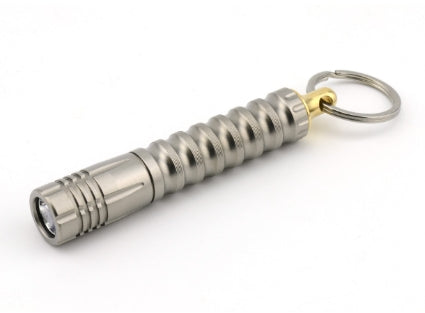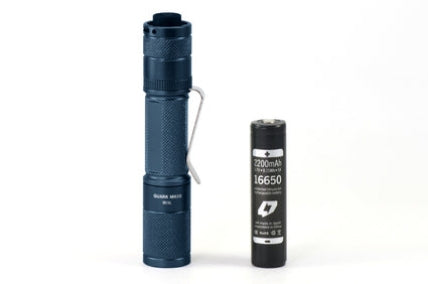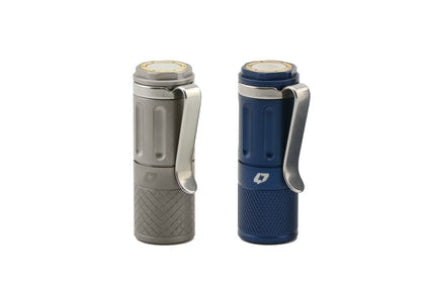Frequently Asked Questions
I do not mean that my light will "beat" any other light in every possible category that you might use to compare flashlights. I mean: in terms of balanced design, engineering, features, performance, ease of repair, and sustainability; you won't find another light in this class.
There are a LOT of other custom flashlight makers these days. Some are good, some are great, but we believe Prometheus lights are still the best. I spent over a decade designing products for other people and I've been designing and manufacturing flashlights since 2010.
It's not that hard these days to make some parts, buy some components, and slap a flashlight together. We go far (far) beyond that and blend engineering, design, human factors, and manufacturing reliability in a way that we believe sets the bar for custom flashlights.
Many products are designed in a way that makes it difficult, if not impossible, to separate an object into it's component parts for repair, recycling, or reuse. Alpha & Delta lights are designed based on the principle of "design for disassembly." This means it's easy to take apart so that it can be repaired, upgraded, or eventually recycled. This flashlight should never need to be thrown away because it can be fixed if something breaks and upgraded when technology changes.
The great thing is, you don't need to be an expert to repair or upgrade our lights. It's designed with the gadget hacker in mind. The entire light can be assembled and disassembled with basic hand tools.
A lumen is the SI unit of luminous flux and is related to the way the human eye perceives light. It is a measure of the total "amount" of light emitted from a source. It does not define how that light is shaped into a directional beam.
Many lights claim output in Watts of power. This doesn't really make sense for LED lights and is a hold-over from incandescent light bulbs. Power is not a measure of brightness, but it's a way to make relative comparisons between light sources. You CANNOT compare the Watts of an incandescent bulb with an LED emitter...apples and oranges.
My lights are tested in an integrating sphere designed to measure OTF lumens. This means you know exactly what you are getting. I test every Blue Label Alpha and Delta light for OTF lumens before I send it out and include the report with each flashlight. OTF lumens are typically 25%-35% lower than rated "emitter lumens" for any flashlight of any kind. It's just physics.
(1) These lights are mass produced, typically in China. That makes them less expensive regardless of the quality. If you want to spend the least amount of money, buy one of those. We make every Alpha and Delta in our shop in Mountain View, CA. If you want to own a unique piece of craftsmanship, made by someone who cares and makes it especially for you, buy one of ours.
(2) Most flashlight brands are owned by Chinese companies based in China. It's cheaper to manufacture in China than in the US, but these companies also have much lower profit margins. It's fine for them to make a few dollars on each light (and that's all they make) because the cost of business is much lower, labor primarily. Most Chinese-owned brands sell their lights for less than the cost of the materials and labor that go into our lights.
(3) The manufacturing quality of many mass-produced lights is often quite excellent. However, the least expensive lights compromise on less expensive components (specifically LEDs) and they are often sub-standard. The cheapest LEDs, which also have the highest lumen output, produce a light that is very blue/purple. Think of the old fluorescent lights and the nasty "cool" color they produce. We use the most premium LEDs on the market and spend a great deal of effort to maximize the accuracy and color of our chosen LEDs. We don't just buy whatever is the cheapest available at the time. We often wait months for the correct "bin" of LED to become available.
(4) Many manufacturers inflate or falsely advertise their lumen rating. I recently saw an XML based light claiming 10,000 lumens. It's just not possible. Cree, the company that manufactures the XML, claims the maximum output for the LED at 1000 lumens. This is under ideal laboratory conditions AND represents the "emitter lumens." No flashlight in the world is actually going to produce that number "out the front" of the light because there are losses in electrical efficiency, heat efficiency, and optical efficiency. You certainly aren't going to get 10x the manufacturer's rated output.
Typically "daylight" is considered to be 6500K (Kelvin). The daylight-balanced photographic film standard is 5600K. Most lights we offer are 4000-5000K neutral white. We choose this range because it's the most natural looking, not too cool and not too warm.
CRI (Color Rendering Index) is a scientific measure of a light sources ability to accurately show colors compared to the sun. The sun scores a perfect 100. We don't produce any light with less than 75 CRI. Most lights we make are 80-90 CRI. Here is a link to a wikipedia article on CRI.
For me, good color rendition is incredibly important and one thing that sets our lights apart from many other name brand flashlights and virtually all off-brand lights. The flashlight world is shifting away from maximum lumens towards better CRI, and we are the company that has led the way.
The short answer is because you appreciate fine tools made by expert craftspeople.
The slightly longer answer is because it represents an idea. I think, as a society, we benefit from being more in touch with where our goods come from, how they are made, and who makes them. I'm selling a perspective on life as much as a product. If you are only concerned with the price and features, this light is probably not for you. If you want to spend your hard earned dollars on a product that is meant to last a lifetime, that represents the way you look at the world, and made by a person and not a faceless corporation, then you are in the right place.
I recently had an interesting conversation where someone told me (I'm paraphrasing) that a $300 flashlight was a display of excessive consumerism and that a $5 big-box special was a more responsible purchasing decision. In my opinion, the situation is exactly the opposite. Buy it once, buy it for life.
Headlamps are great for a lot of special use cases. However, a headlamp is not a replacement for a flashlight and vice versa. You have to have the right tool for the job. If you want massive power, wearing it on your head is not a very good option (ie. blinding others). If you want hands-free, a flashlight is not a very good option (ie. it requires a hand).
One reason I really like flashlights is because they're the best form factor for use cases that are unexpected. I use my headlamp when I know what I'll be using it for and expect my hands to be full. I carry a flashlight because I don't know when I'll need it or what I'll need it for. It hangs out in my pocket until I drop my keys in the dark, when I'm trying to fix a broken radiator hose at a rest stop at night, or when I need to make a midnight fridge run and don't want to wake everyone else up.




